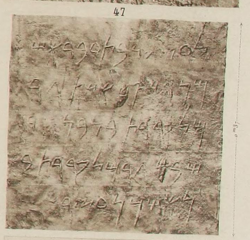Kellia inscription
Topic: Social
 From HandWiki - Reading time: 3 min
From HandWiki - Reading time: 3 min
The Kellia inscription is a Phoenician inscription found in the church of St Anthony in Kellia, Cyprus (Greek: Άγιος Αντώνιος Κελλιά) by Ludwig Ross in 1844. It is a funerary inscription of a noblewoman, the daughter of a Shophet.[1] It is 1 foot wide and 2 and 3/4 feet high.[2]
On its discovery, Ludwig Ross noted that he had been searching throughout Cyprus for inscriptions similar to the 33 Pococke Kition inscriptions found in 1738, but found only two:
I expected to find a greater number of Phoenician monuments on this island; but the ruins of the cities there have been used, at least since the times of the Lusignans and the Venetians, uninterruptedly as quarries for new buildings, and almost all of them have been razed to the ground. In addition, the usual material there is only a soft type of sandstone, which is much more easily subject to destruction than limestone or marble. It is due to these two reasons that Cyprus only grants a poor yield of both Greek and Phoenician inscriptions. In Kition and the surrounding area, where up to thirty (33) Phoenician inscriptions were counted in the last century, I have, in spite of the most persistent inquiries, been able to find only two. I found a third Phoenician inscription of six lines in the capital Nicosia, but so destroyed that hardly any letters were recognizable ... In the Church of Saint Anthony, in the village of Kellia, three quarters of an hour north of Kition, in the middle of a large stele made of white marble walled over one of the inner vaults of the church.[3]
It is known as KAI 36 and CIS I 47.
Notes
- ↑ Ferdinand Benary, Franz (1845). "Bericht über zwei phönicische Inschriften". Bericht über die zur Bekanntmachung geeigneten Verhandlungen der Königl. Preuss. Akademie der Wissenschaften zu Berlin (Königlich Preussische Akademie der Wissenschaften zu Berlin; Gedruckt in der Druckerei der Königl. Akademie der Wissenschaften): 250. https://books.google.com/books?id=ZM8DAAAAMAAJ&pg=PA250. "Sie ist, wie der Inhalt zeigt, eine Grabschrift, und zwar eines vornehmen Weibes, der Tochter eines Suffeten, und also zu lesen.".
- ↑ Ross, Ludwig (1846). "Ueber Drei in Cypern Gefundene Phönicische Inschriften". Hellenika, von L. Ross. p. 118. https://digi.ub.uni-heidelberg.de/diglit/hellenika1846/0153/image.
- ↑ Ferdinand Benary, Franz (1845). "Bericht über zwei phönicische Inschriften". Bericht über die zur Bekanntmachung geeigneten Verhandlungen der Königl. Preuss. Akademie der Wissenschaften zu Berlin (Königlich Preussische Akademie der Wissenschaften zu Berlin; Gedruckt in der Druckerei der Königl. Akademie der Wissenschaften): 250. https://books.google.com/books?id=ZM8DAAAAMAAJ&pg=PA250. "Ross: "Ich erwartete auf dieser Insel eine grössere Zahl Phönicischer Monumente zu finden; allein die Ruinen der dortigen Städte haben, wenigstens seit den Zeiten der Lusignans und der Venetianer, ununterbrochen als Steinbrüche für Neubauten gedient, und sind fast alle dem Boden gleich gemacht worden. Dazu kommt, dass das gewöhnliche Material dort nur eine weiche Sandsteinart ist, die der Zerstörung weit leichter unterworfen als Kalkstein oder Marmor. Diesen beiden Ursachen ist es zuzuschreiben, dass Cypern sowohl an Griechischen als an Phönicischen Inschriften nur eine ärmliche Ausbeute gewährt. In Kition und der Umgegend, wo man im vorigen Jahrhundert bis zu dreissig (33) Phönicische Inschriften zählte, habe ich, trotz den beharrlichsten Nachforschungen, nur zwei aufzufinden vermocht. Eine dritte Phönicische Inschrift von sechs Zeilen fand ich in der Hauptstadt Leucosia (Nicosia), aber so zerstört, dass kaum noch einige Buchstaben erkenntlich waren... In der Kirche des heil. Antonios, in dem Dorfe Kellia, drei Viertelstunden nördlich von Kition (Larnaka), in der Mitte einer grossen Stele von weissem Marmor, die über einem der innern Gewölbe der Kirche eingemauert ist.”".
 |
 KSF
KSF
